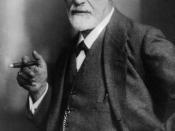The psychologist Sigmund Freud created many theories on how people are and why they do the things they do. His psychoanalytic theories are used today to for a better understanding of and to analyze literature. Freud's three key zones of mental process are the id, the ego and the superego. The id is one of the most important of the three when talking about "Little Red Riding Hood" by Charles Perrault. The author tries to show that being impulsive and basically giving in to your id is not the best way to live one's life.
In the beginning of "Little Red Riding Hood", the little girl is happily skipping through the forest. "...she met a wolf, who wanted to eat her..." (Stories, 1066) and proceeds to have a friendly conversation with him. This is her first mistake. Being young and uninformed about the ways of the world, she thinks it is perfectly normal to talk to a big, scary wolf.
"The poor child did not know how dangerous it is to chatter away to wolves..." (Stories, pg. 1066). Since the little girl is young and impressionable, she jumps on her impulses to talk to any stranger she comes across. She does not think of what could come of her informing the wolf of her every move. She is not concerned with what might happen due to her irrational choice of speaking with a similarly irrational wolf.
The wolf is also guilty of giving in to his amoral desires. When he first sees the little girl, he "...wanted to eat her but did not dare to because there were woodcutters working nearby." (Stories, pg. 1066) He refrained from giving into his impulses only because he was afraid of being hurt by the people nearby. However, the wolf...



Confused.
I found this paper to be well written. It was very interesting to read.
The only thing I am lost on is how you managed to bring in the wolves sexual desires. He wanted to eat Red Riding Hood, not sleep with her.
If you wanted to bring in sexual desires or sexual predators, you would have needed to provide a link and segue into it.
1 out of 1 people found this comment useful.